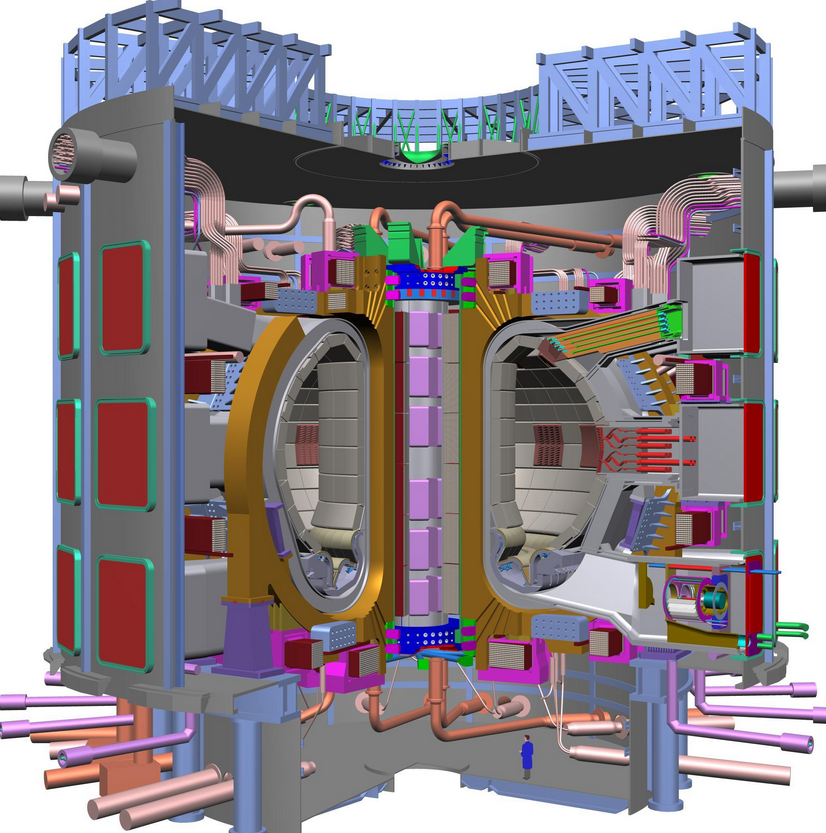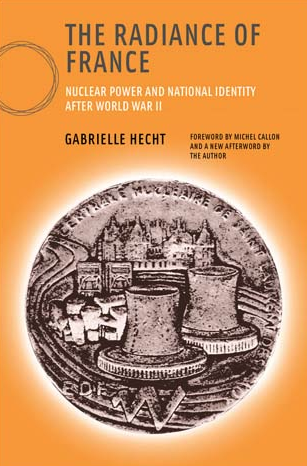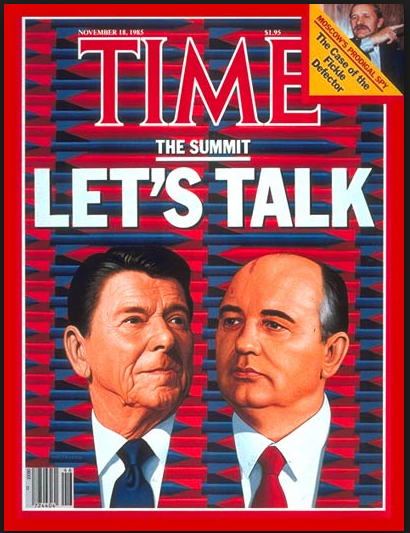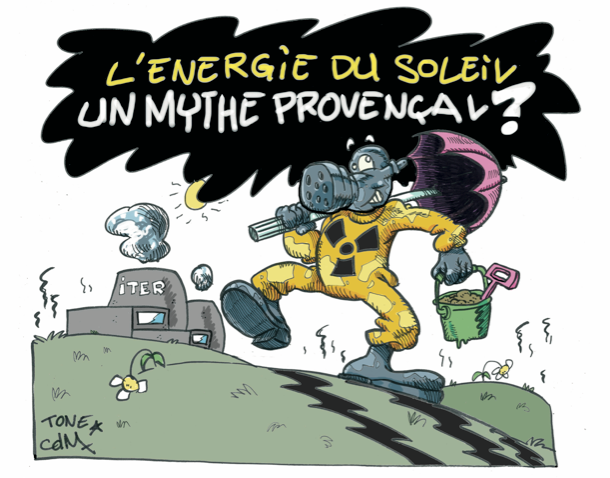A (Con)Fusion of Money and Politics
In 2010, I had the good fortune to spend several months in southern France. It wasn't all rosé wine and boules though. I also researched and wrote an article (which you can read here) about the International Thermonuclear Experimental Reactor, now known simple as ITER. Pronounced something close to “eater” (as in eater of budgets), it also means “the way” in Latin (as in advocates hope, this is "the way to boundless clean energy"). ITER is the global fusion community’s most ambitious project to date. It is also one of the longest-running, most expensive, and most troubled science projects ever.Under construction in southern France near the tiny town of St. Paul les Durance, just east of Aix-en-Provence and adjacent to the French nuclear facility at Cadarache, ITER is a fusion energy facility based around a massive tokamak reactor. Taken from the Russian acronym for toroidal kamera magnetik (“toroidal chamber with magnetic coils”) – a tokamak magnetically confines a plasma into a doughnut-shaped space, producing high temperatures. The fuel will be a mixture of deuterium and tritium, two isotopes of hydrogen, than when heated to temperatures in excess of 150 million°C form a hot plasma. The heat drawn from the plasma can be used to boil water, make steam, and generate energy. Like conventional nuclear reactors, ITER is, in essence, a giant teakettle. Since the project really got started in 2006, its expected completion date has slipped from 2016 to 2018 to 2020. Meanwhile, costs have ballooned. The project's official website doesn't even give a price: "Based on the European evaluation, we can estimate the cost of ITER construction... at approximately EUR 13 billion" with the caveat that this is "if all the manufacturing was done in Europe." (ITER's components will be manufactured by all the project's partners in a manner proportional - somewhat -to their contributions.) However, a recent article in Science estimates a cost of some €16 billion (i.e. about $22 billion). ((Moreover, a recent story in Physics Today notes that if estimates from the U.S. Office of Science's are correct, the actual cost might approach $50 billion. This seems to be an extremely high estimate, however.))Perhaps even more impressive that its cost is its scope. ITER is a joint international effort; its partners include the E.U., the U.S., Russia, China, India, Japan, and South Korea. This megaproject represents over half of the world's population. Like the former British empire, the sun never sets on ITER.
Since the project really got started in 2006, its expected completion date has slipped from 2016 to 2018 to 2020. Meanwhile, costs have ballooned. The project's official website doesn't even give a price: "Based on the European evaluation, we can estimate the cost of ITER construction... at approximately EUR 13 billion" with the caveat that this is "if all the manufacturing was done in Europe." (ITER's components will be manufactured by all the project's partners in a manner proportional - somewhat -to their contributions.) However, a recent article in Science estimates a cost of some €16 billion (i.e. about $22 billion). ((Moreover, a recent story in Physics Today notes that if estimates from the U.S. Office of Science's are correct, the actual cost might approach $50 billion. This seems to be an extremely high estimate, however.))Perhaps even more impressive that its cost is its scope. ITER is a joint international effort; its partners include the E.U., the U.S., Russia, China, India, Japan, and South Korea. This megaproject represents over half of the world's population. Like the former British empire, the sun never sets on ITER. Wavering support for ITER in the U.S. is nothing new. ITER began as a creature formed by the fusion of money and politics. In her prize-winning 1998 book The Radiance of France, my colleague Gabrielle Hecht deploys the term “technopolitics.” Defined as “designing or using technology to constitute, embody, or enact political goals,” Hecht'd book asked the question of “what was French about the French nuclear program?”
Wavering support for ITER in the U.S. is nothing new. ITER began as a creature formed by the fusion of money and politics. In her prize-winning 1998 book The Radiance of France, my colleague Gabrielle Hecht deploys the term “technopolitics.” Defined as “designing or using technology to constitute, embody, or enact political goals,” Hecht'd book asked the question of “what was French about the French nuclear program?” ITER’s history shows similar technopolitics at the very roots of this mega-project. The key difference here, is that ITER's technopolitics transcended national identity and state politics and moved to a much larger global arena. Consider ITER's origins: ((Note: a massive repository for fusion and ITER history is here...it's a fascinating place to explore.))After World War Two, the most active fusion programs were in the U.S. and the USSR while initial European efforts remained quite modest. Military classification initially prevented the international exchange of scientific and technical information about fusion but these constraints began to loosen following the Eisenhower administration’s “Atoms for Peace” initiative.In the late 1970s, there were plans to build a new Europe-only fusion reactor. This was imagined as a cooperative transnational European project that would provide a bridge to a future commercially viable reactor. Before these efforts gained any traction, however, a Soviet delegation proposed building an international “Large Tokamak of the next generation” under the auspices of the International Atomic Energy Agency (IAEA). The IAEA referred the Soviet proposal to its own advisory body which then organized a series of workshops to discuss cooperation between Europe, the U.S., the Soviets, and Japan to build an “International Tokamak Reactor." Negotiations followed but the sudden end of U.S.-Soviet détente after the '79 Soviet invasion of Afghanistan quashed progress.Meanwhile, European plans became entangled in U.S. science policy. European fusion managers expressed reservations about the relative prioritization of their goals versus what American science managers were interested in. Were American researchers proposing a fusion research collaboration in order to better understand plasma physics or as steps toward building a future power-generating device? The Americans, as European researchers saw it, were more oriented towards basic science, a belief reinforced by George A. Keyworth, Reagan’s science advisor. Keyworth’s emphasis on basic science conflicted with the underlying long-term European goal of developing fusion technologies for energy applications and eventual “industrial production and marketing." Meanwhile, some U.S. politicians indicated reluctance to support international collaborations which involved sharing manufacturing technology with the Soviets (a risk to national security) or the Europeans and Japanese (a risk to U.S. economic competitiveness).Hints of new-found political will to move forward with some sort of international fusion project eventually appeared but came, rather unexpectedly, from heads of state and not laboratory directors. In the fall of 1985, before the first summit between Reagan and Mikhail Gorbachev, Secretary of State George Schultz met with Soviet Foreign Minister Eduard Shevardnadze. At the suggestion of Evgeny Velikhov, a fusion physicist who advised Gorbachev on science, Shevardnadze proposed adding international cooperation in nuclear fusion to the agenda.
ITER’s history shows similar technopolitics at the very roots of this mega-project. The key difference here, is that ITER's technopolitics transcended national identity and state politics and moved to a much larger global arena. Consider ITER's origins: ((Note: a massive repository for fusion and ITER history is here...it's a fascinating place to explore.))After World War Two, the most active fusion programs were in the U.S. and the USSR while initial European efforts remained quite modest. Military classification initially prevented the international exchange of scientific and technical information about fusion but these constraints began to loosen following the Eisenhower administration’s “Atoms for Peace” initiative.In the late 1970s, there were plans to build a new Europe-only fusion reactor. This was imagined as a cooperative transnational European project that would provide a bridge to a future commercially viable reactor. Before these efforts gained any traction, however, a Soviet delegation proposed building an international “Large Tokamak of the next generation” under the auspices of the International Atomic Energy Agency (IAEA). The IAEA referred the Soviet proposal to its own advisory body which then organized a series of workshops to discuss cooperation between Europe, the U.S., the Soviets, and Japan to build an “International Tokamak Reactor." Negotiations followed but the sudden end of U.S.-Soviet détente after the '79 Soviet invasion of Afghanistan quashed progress.Meanwhile, European plans became entangled in U.S. science policy. European fusion managers expressed reservations about the relative prioritization of their goals versus what American science managers were interested in. Were American researchers proposing a fusion research collaboration in order to better understand plasma physics or as steps toward building a future power-generating device? The Americans, as European researchers saw it, were more oriented towards basic science, a belief reinforced by George A. Keyworth, Reagan’s science advisor. Keyworth’s emphasis on basic science conflicted with the underlying long-term European goal of developing fusion technologies for energy applications and eventual “industrial production and marketing." Meanwhile, some U.S. politicians indicated reluctance to support international collaborations which involved sharing manufacturing technology with the Soviets (a risk to national security) or the Europeans and Japanese (a risk to U.S. economic competitiveness).Hints of new-found political will to move forward with some sort of international fusion project eventually appeared but came, rather unexpectedly, from heads of state and not laboratory directors. In the fall of 1985, before the first summit between Reagan and Mikhail Gorbachev, Secretary of State George Schultz met with Soviet Foreign Minister Eduard Shevardnadze. At the suggestion of Evgeny Velikhov, a fusion physicist who advised Gorbachev on science, Shevardnadze proposed adding international cooperation in nuclear fusion to the agenda. As an arena for Cold War superpower collaboration, fusion made sense for several reasons. For one thing, an international research community and pathways for information exchange already existed. Second, clean energy via nuclear fusion offered the semblance of broad societal benefits. It also had the potential to put a more positive face on nuclear applications at a time when the superpowers’ nuclear arsenals drew widespread global condemnation. ((Ironically, similar motivations were behind Eisenhower’s “Atoms for Peace” program.)) Finally, while technically possible, practicable applications of fusion energy still remained many years off, making it a fairly safe arena for U.S.-Soviet collaboration in terms of technology sharing.When the Geneva summit concluded, Reagan and Gorbachev issued a joint statement which was pure technopolitics. To further superpower cooperation and perhaps ease global tensions, the two leaders endorsed “the potential importance of…utilizing controlled thermonuclear fusion” and advocated “practicable development of international cooperation” to achieve this. When Reagan briefed Congress on his summit trip, he identified international cooperation in fusion as one part “of a long-term effort to build a more stable relationship” with the Soviets and the two leaders repeated their backing for an international fusion reactor at subsequent meetings. The seeds for ITER - planted some years back - slowly started to germinate.This was nearly thirty years ago. Think about it...when Ronny and Gorbie got ITER started, the Norwegian band A-Ha was on the top of the pop charts.
As an arena for Cold War superpower collaboration, fusion made sense for several reasons. For one thing, an international research community and pathways for information exchange already existed. Second, clean energy via nuclear fusion offered the semblance of broad societal benefits. It also had the potential to put a more positive face on nuclear applications at a time when the superpowers’ nuclear arsenals drew widespread global condemnation. ((Ironically, similar motivations were behind Eisenhower’s “Atoms for Peace” program.)) Finally, while technically possible, practicable applications of fusion energy still remained many years off, making it a fairly safe arena for U.S.-Soviet collaboration in terms of technology sharing.When the Geneva summit concluded, Reagan and Gorbachev issued a joint statement which was pure technopolitics. To further superpower cooperation and perhaps ease global tensions, the two leaders endorsed “the potential importance of…utilizing controlled thermonuclear fusion” and advocated “practicable development of international cooperation” to achieve this. When Reagan briefed Congress on his summit trip, he identified international cooperation in fusion as one part “of a long-term effort to build a more stable relationship” with the Soviets and the two leaders repeated their backing for an international fusion reactor at subsequent meetings. The seeds for ITER - planted some years back - slowly started to germinate.This was nearly thirty years ago. Think about it...when Ronny and Gorbie got ITER started, the Norwegian band A-Ha was on the top of the pop charts. Since 1985, the U.S. has left the project, re-joined it, and threatened to leave it again more than once. (I've actually lost count.) Along the way, all sorts of complicated politics - where to build the fusion facility (France vs. Spain vs. Japan?) as well as European opposition to the 2003 Iraq War - threatened to derail the whole entire thing. Meanwhile, anti-nuclear and anti-corporate groups in France protested the entire project (and the massive investments regional and national French officials had made in it). Technopolitics indeed.
Since 1985, the U.S. has left the project, re-joined it, and threatened to leave it again more than once. (I've actually lost count.) Along the way, all sorts of complicated politics - where to build the fusion facility (France vs. Spain vs. Japan?) as well as European opposition to the 2003 Iraq War - threatened to derail the whole entire thing. Meanwhile, anti-nuclear and anti-corporate groups in France protested the entire project (and the massive investments regional and national French officials had made in it). Technopolitics indeed. In 1995, Hubert Curien, then serving as president of the Organization Européenne pour la Recherche Nucléaire (CERN), described ITER as “globalization with hardware.” ((Comment made during a 1995 round table discussion, in Florence, Italy about European research cooperation; John Krige and Luca Guzzetti, eds., History of European Scientific and Technological Collaboration. Brussels: European Commission, 1997.)) From its inception, ITER and its predecessors were enmeshed in politics at many levels, from the regional and national to the global. First conceived as a tool to improve relations between Cold War superpowers, ITER became an opportunity for “Old Europe” to project an image of unity and a tool to reward countries if they aligned themselves with American foreign policies.Since 1985, a whole new generation of fusion scientists has entered the fusion community. Do they know the project's long and tortured history? This - to me - is a fascinating question. I'm sure that younger scientists have heard stories and myths about ITER's early days. What are these creation tales like, I wonder? Do the veterans tell the newcomers about how ITER - if or when it's built - will be a site not just for the fusion of light elements, but of technological ambitions, money, and politics of all kinds?Update: Just after I posted this, I learned about a lengthy feature piece on ITER from the brand-new (3 March 2014) issue of the New Yorker. It's worth a read and it gets at the same issues - politics, money, and technological ambitions - noted here...
In 1995, Hubert Curien, then serving as president of the Organization Européenne pour la Recherche Nucléaire (CERN), described ITER as “globalization with hardware.” ((Comment made during a 1995 round table discussion, in Florence, Italy about European research cooperation; John Krige and Luca Guzzetti, eds., History of European Scientific and Technological Collaboration. Brussels: European Commission, 1997.)) From its inception, ITER and its predecessors were enmeshed in politics at many levels, from the regional and national to the global. First conceived as a tool to improve relations between Cold War superpowers, ITER became an opportunity for “Old Europe” to project an image of unity and a tool to reward countries if they aligned themselves with American foreign policies.Since 1985, a whole new generation of fusion scientists has entered the fusion community. Do they know the project's long and tortured history? This - to me - is a fascinating question. I'm sure that younger scientists have heard stories and myths about ITER's early days. What are these creation tales like, I wonder? Do the veterans tell the newcomers about how ITER - if or when it's built - will be a site not just for the fusion of light elements, but of technological ambitions, money, and politics of all kinds?Update: Just after I posted this, I learned about a lengthy feature piece on ITER from the brand-new (3 March 2014) issue of the New Yorker. It's worth a read and it gets at the same issues - politics, money, and technological ambitions - noted here...